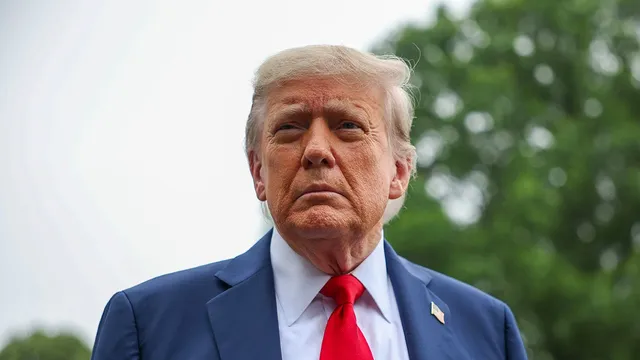
Trump imposes 25% tariff on Japanese and South Korean imports
2025-07-07 20:10- President Trump sent letters to Japan and South Korea announcing the imposition of a 25% tariff on imports beginning August 1.
- The tariffs aim to address the significant trade deficits the U.S. has with these nations, and they may be adjusted based on future relations.
- Stock markets reacted negatively to the announcement, with significant drops in shares of Japanese automakers.
Express your sentiment!
Insights
On July 7, 2025, President Donald Trump took a significant step in trade policy by notifying Japan and South Korea about new tariffs on their imports to the United States. Each country will face a 25% tariff beginning August 1, a move aimed at addressing the ongoing trade deficits with these key allies. The letters detailing this decision were shared publicly on Trump's Truth Social account and were communicated to the heads of government in both nations, signaling a decisive escalation in America's trade approach. The tariffs imposed on Japan and South Korea are part of Trump’s broader strategy to recalibrate trade relationships and ensure a more reciprocal trading framework. He pointed out the long-standing trade disparities America has faced, emphasizing that the tariffs will remain in effect unless the affected countries either reduce their own tariffs on U.S. goods or take steps to address trade barriers. The correspondence makes it clear that if Japan or South Korea retaliate by raising tariffs on American products, these incremental costs will be added to the 25% tariffs, further complicating trade dynamics. Responding to economic concerns, Trump indicated that the new tariff rates communicated in his letters could still be adjusted based on the evolving nature of the relationships with Japan and South Korea. Alongside the threat of increased tariffs, he suggested that there would be no tariffs imposed if Japanese or South Korean companies opt to manufacture goods within the United States. This assertion reflects an intent to stimulate local manufacturing and improve job creation within the U.S., but also highlights the urgency for these nations to engage in negotiations that would mitigate the need for such tariffs. The announcement was met with immediate backlash in stock markets, with declines noted among major market indices and significant stocks of Japanese automakers like Toyota and Honda. Investors reacted negatively with concerns that the tariffs would escalate into a trade war or further disrupt global supply chains. Japanese and South Korean leaders are now faced with the challenge of navigating these new tariffs while balancing their respective economic strategies and maintaining productive relationships with the United States. As a partner, Japan is notably America's sixth-largest trading partner, while South Korea ranks seventh, making the implications of these tariffs critical not just for bilateral trade but for broader international economic stability.
Contexts
The history of U.S. tariffs imposed by President Donald Trump has significantly influenced both domestic and international trade dynamics. Initiated in 2018, Trump's administration adopted a protectionist stance aimed at reducing the U.S. trade deficit, prioritizing American manufacturing, and countering practices considered unfair by trading partners, particularly China. The tariffs began with a notable increase on imported steel and aluminum, set at 25% and 10% respectively, under Section 232 of the Trade Expansion Act of 1962, citing national security concerns. This marked the beginning of a series of tariff measures that expanded to various goods and sectors, as the administration sought to leverage tariffs as a tool of economic policy and negotiation tactics with other countries. In 2018, following the steel and aluminum tariffs, the Trump administration introduced additional tariffs targeting approximately $350 billion worth of Chinese goods, asserting that these sanctions were necessary to combat China's intellectual property theft and unfair trade practices. The tariffs, which ranged from 10% to 25%, impacted a diverse array of products, from electronics to consumer goods. This series of duties led to retaliatory measures from China, which imposed its own tariffs on U.S. exports, particularly agricultural products, thus initiating a tit-for-tat trade war that had substantial repercussions for both economies and global trade. Throughout 2019, a delicate negotiation process ensued, culminating in a phase one trade agreement between the U.S. and China in January 2020, wherein China agreed to purchase more American goods and address some of the issues surrounding intellectual property. However, despite the agreement, many of the original tariffs remained in place, signaling a long-term shift in U.S. trade policy. Moreover, tariffs on other countries, including the European Union and Canada, dealt a blow to various industries, leading to increased costs for U.S. consumers and the disruption of supply chains that affected countless businesses. The economic ramifications of the tariffs have sparked intense debates among economists and policymakers. Supporters argue that tariffs are crucial for protecting American jobs and industries, while critics contend that they lead to higher prices for consumers and retaliatory measures that can harm U.S. exports. Additionally, the COVID-19 pandemic further complicated these issues, showcasing vulnerabilities in global supply chains exacerbated by the trade tensions. As we move forward, the lasting impact of Trump's tariff policies remains to be fully assessed, particularly in light of changing administrations and evolving geopolitical relations.